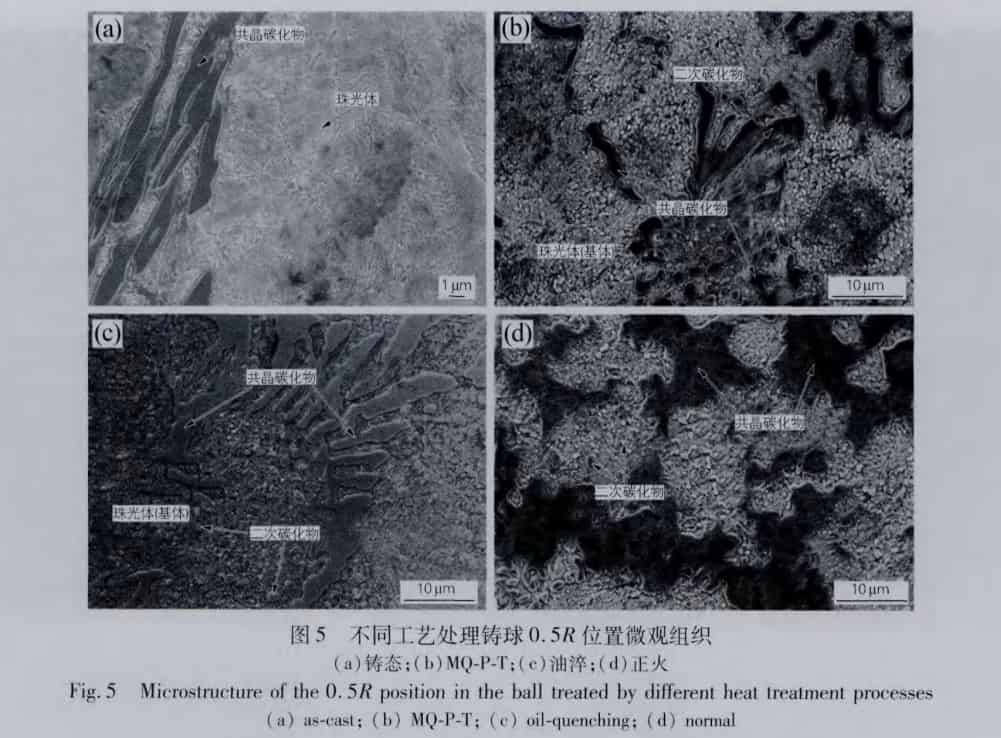Application of new MQ-P-T technology in white casing grinding balls (3)
3.Discuss
On the one hand, the addition of chromium in casting grinding ball decreases the carbon content of the eutectic point and decreases the austenite area in the phase diagram. On the other hand, the type of carbide structure changes from reticulate M3C type to isolated M7C3 type, and the hardness of carbide increases, from 850 ~ 1100HV of M7C3 to M, C and 1300 ~ 1500hv of M7C3, the wear resistance and toughness are improved. Stable M7C3 eutectic carbides can be obtained easily by adding 10% ~ 25% CR into the matrix containing 2% ~ 3% C in conventional heat treatment.
By observing the surface, 0.5 radii (0.5 R), and the center of the casting grinding ball under the light microscope, it can be found that the original structure of the cast ball is composed of room temperature ledeburite, pearlite, and reticulate eutectic carbide, as shown in Fig. 4(a) ~ (c).
Fig. 4(d) ~ (f) is the microstructure of tempered martensite (bainite), retained austenite, eutectic carbides, and dispersed secondary carbides after MQ-P-T treatment. In the as-cast structure, the eutectic carbides are coarse and interlaced, and the matrix is split. The LEDEBURITE structure is formed with the subsequent lamellar pearlite; after MQ-P-T treatment, the carbides are refined and dispersed (as shown in Fig. 4(e), (f). Meanwhile, the matrix microstructure is refined. The refined grains are strengthened after the MQ-P-T treatment, contributing to the improvement of wear resistance and casting grinding balls’ mechanical properties.
Fig. 4(g) ~ (i) is the surface’s microstructure, 0.5 R, and center of the cast ball after air cooling treatment, respectively. It is eutectic carbide, secondary carbide, and black pearlite. As shown in Fig. 4(j) ~ (l), the microstructure of surface, 0.5r, and center of high chromium casting grinding ball after oil quenching treatment is eutectic carbide, secondary carbide, martensite, and austenite. As shown in Figure 4, the casting grinding ball’s center is much coarser than the surface due to the segregation of components during casting.
The as-cast original microstructure showed dark dendrites and bright skeletal eutectic carbides distributed between the dendrites under the light microscope. The dendrite originates from the proeutectic transformation of austenite. The microstructure of MQ-P-T and NOR samples is similar to that of as-cast samples, and they still show net eutectic carbides and dendrites formed by the transformation of eutectic austenite, but the microstructure between dendrites can not be distinguished. Therefore, further characterization was carried out by SEM. Fig. 5 is the scanning image of 0.5 radius of cast ball after different processing. The amount of secondary carbides in the MQ-P-T sample (Fig. 5(b)) is much larger than that in other process samples (Fig. 5(b) ~ (d)).
The retained austenite and martensite in MQ-P-T samples can not be distinguished by SEM, so TEM field image and selected area electron diffraction are used to characterize the MQ-P-T samples, as shown in Fig. 6. The structures of MQ-P-T include: (a) HCPM7C3 secondary or eutectic carbides, (b) nanosheets, spacer beads, light bodies, (c) twin martensite, (D) retained austenite, austenite, and dislocation martensite. Through the selected area electron diffraction spectra, their Nishiyama-Wasserman phase correlation is ([001] < 011] , (110)//(111) . Two points need to be pointed out. According to the morphology, pearlite, in the M3C alloy carbide, and M7C3 secondary carbon, carbide. The other is the formation of low carbon dislocation type Ma, austenite and high carbon twin, crystal martensite, indicating that the austenite's carbon is non-uniform, distributed.
4.Conclusion
1) on the premise of avoiding cracking and failure, water and air are used as quenching medium for the first time to realize quenching and treatment of 80mm high chromium cast ball, effectively replacing oil, salt, and another quenchant to realize zero-emission.
2) compared with the traditional oil quenching and normalizing treatment, after the MQ-P-T process, the high chromium cast ball is not, but has a very high hardness and uniformity. It is mainly attributed to the MQ-P-T process, after treatment, high chromium, cast iron obtained MA, martensite matrix, and a large number of refined, secondary M7C3 carbide.
3) after treated by the MQ-P-T process, the average impact toughness is 12.6 J/cm, which is about 4 times of air cooling and 2 times of oil quenching. The microstructure study shows that the improvement of toughness after MQ-P-T treatment is related to a large amount of low carbon martensite and stable carbon-rich austenite.




